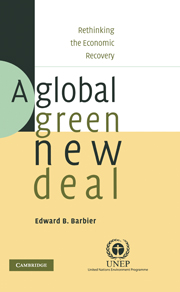Book contents
- Frontmatter
- Contents
- List of figures
- List of tables
- List of boxes
- Foreword
- Preface
- Acknowledgements
- Part I Why a Global Green New Deal?
- Part II The Key Components of a Global Green New Deal
- Part III The Role of the International Community
- Part IV Towards a Greener World Economy
- Appendix 1 PIIE–WRI analysis of a green recovery program for the United States
- Appendix 2 Pew comparative analysis of clean energy jobs and investments in the United States, 1998–2007
- Glossary
- Index
Part IV - Towards a Greener World Economy
Published online by Cambridge University Press: 05 June 2012
- Frontmatter
- Contents
- List of figures
- List of tables
- List of boxes
- Foreword
- Preface
- Acknowledgements
- Part I Why a Global Green New Deal?
- Part II The Key Components of a Global Green New Deal
- Part III The Role of the International Community
- Part IV Towards a Greener World Economy
- Appendix 1 PIIE–WRI analysis of a green recovery program for the United States
- Appendix 2 Pew comparative analysis of clean energy jobs and investments in the United States, 1998–2007
- Glossary
- Index
Summary
As stated in part I, the premise of this book is that the current global economic crisis has spurred governments to instigate a worldwide recovery. This provides a unique opportunity to address other important global economic and environmental challenges as well. The Global Green New Deal outlined in this book is aimed at achieving both objectives.
In sum, the GGND is not just about creating a greener world economy. It is about ensuring that the correct mix of economic policies, investments and incentives is adopted in order to reduce the carbon dependency of the world economy, protect vulnerable ecosystems and alleviate poverty while also fostering economic recovery and creating jobs.
Implicit in this is the recognition that the looming global problems of climate change, water scarcity and extreme global poverty mean that the world should not rely solely on massive fiscal stimulus packages for reviving the economy and creating jobs. Instead, what is called for is a balanced combination of policies and measures in a Global Green New Deal that has been carefully calibrated to meet the multiple economic and environmental challenges.
Reviving the world economy remains a necessity, however. That is why this book has included as part of the proposed GGND actions that can be implemented over the next several years and that will have an immediate and effective impact on the main objectives of the strategy.
- Type
- Chapter
- Information
- A Global Green New DealRethinking the Economic Recovery, pp. 211 - 213Publisher: Cambridge University PressPrint publication year: 2010



